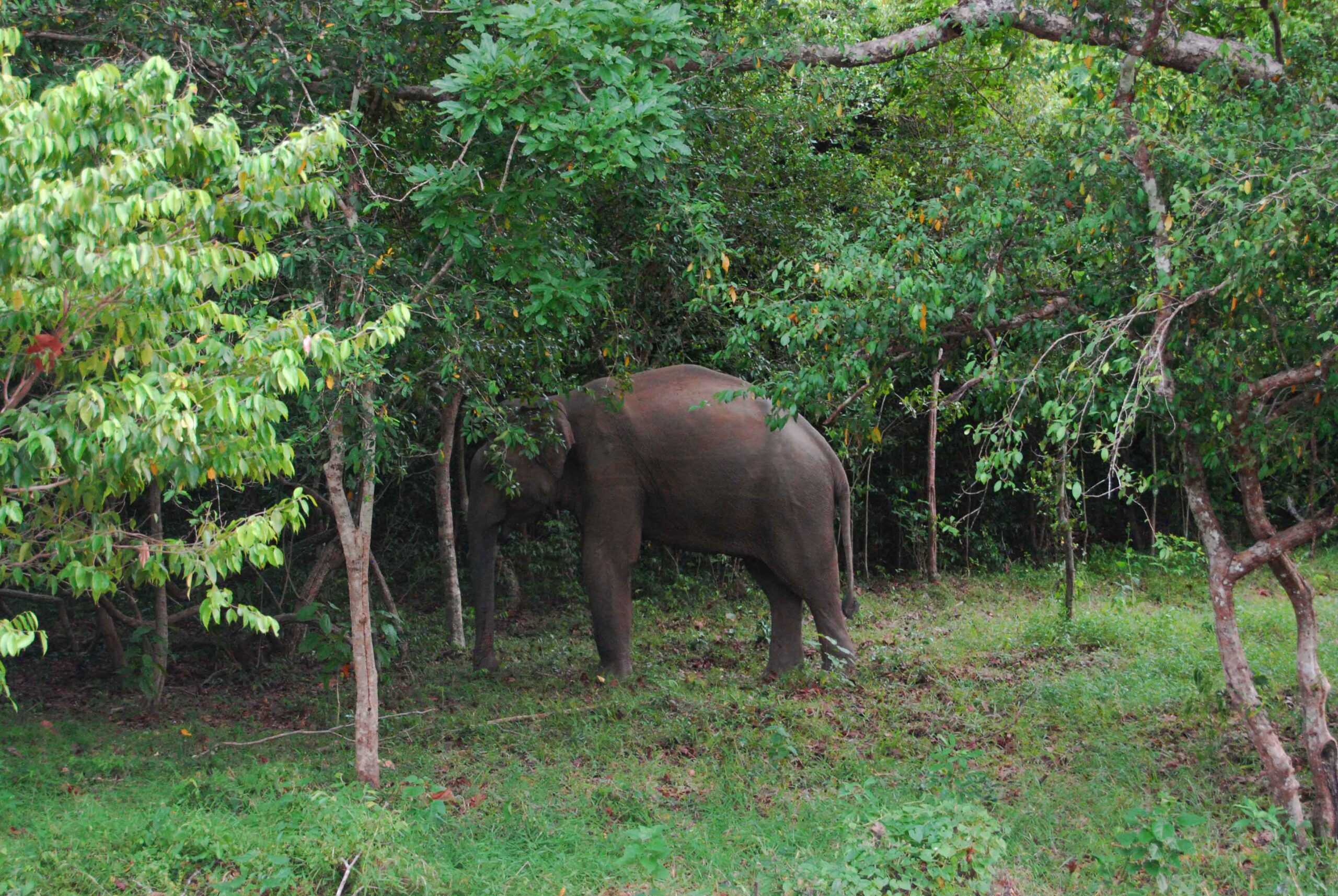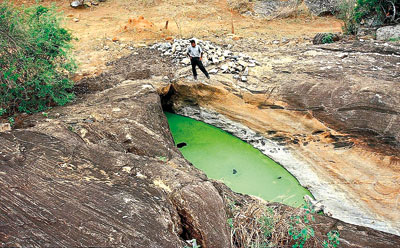
To get sand, they’ll even burn down a forest
Opportunists burning down our forests simply in order to collect sand cheaply are amongthes whose actions have caused about 4,570 acres of forest and scrub to go up in flames this year alone.
“They do this because when it rains after a fire, all the solid is washed down into the streams and rivers which makes it easier to collect sand,” Forest Conservation Department Director, Anura Sathurusinghe said.
“This causes water springs to dry up, injury and death to wild animals and completely destroys the natural processes of the environment,” he said.
Fires have been burning in Hambantota, Nuwara Eliya, the Knuckles Range Monaragala, Anuradhapura and Badulla, and Mr. Sathurusinghe said most of them have been set alight by sand miners, poachers and cattle-owners razing forest land for pasture for their herds are mainly responsible for the forest fires.
Environmentalists say it may take more than many decades to restore the balance in the environment, following the destruction of the forests.
The arson has also had a severe impact on crops. Cinnamon crops and chena cultivations have been completely destroyed.
The fires were worsening the already-high air pollution over Sri Lanka, while also destroying forest ecosystems and affecting nesting birds and other animals, environmentalist, Lahiru Supun Prakash of the Biodiversity Conservation and Research Circle said.
The burning down of trees, Mr. Prakash added, was also damaging the country’s ability to combat greenhouse gas emissions. Trees absorb and store carbon from the atmosphere, so the more trees that are burned the harder it becomes to combat climate change in the future.
“These fires are causing severe consequences to the environment. Important plants, waterways are destroyed. There is an increased risk of landslides, and they also have an adverse effect on weather patterns, causing droughts in the future,” Disaster Management Ministry Deputy Director, Sarath Lal Kumara said.
“We believe that the best way to tackle this problem is by creating awareness as many of the offenders go undetected while the police will not make any arrests without proof.”
But the thick smoke and remote and difficult, mountainous terrain were making the job difficult for firefighters, army soldiers and forest guards deployed to battle the flames, Mr. Kumara said adding that, nearby villagers have been asked to stay on alert but none has yet been asked to evacuate.
Arsonists can be fined up to Rs. 50,000 or be given a two to five-year sentence, Mr. Sathurusinghe said,
Mr. Prakash said it was fortunate that many of the fires are either in grassland areas or plantations of eucalyptus or pine so that the impact native forests and biodiversity was some on what limited.
Source : October,2016 Sunday Times http://www.sundaytimes.lk/161002/news/to-get-sand-theyll-even-burn-down-a-forest-211020.html

What price for Nature’s ‘greenbacks’ – the forests?
Conservationists are debating whether working out a rupee value for forests would convince money-crunching bureaucrats that preserving them makes more economic sense than stripping woodland for income-producing purposes.
“Many people consider forest as a waste of land where utilising that terrain for other purposes can bring income, also contributing to the national economy. But forests provide other services such as delivering the fresh water we drink and the clean air we breathe whereas if we lose these services it will cost a lot of money to implement costly alternatives,” the Conservator-General of Forests, Anura Sathurusinghe said.
“It is often a big challenge to communicate this value to politicians and officials who mainly understand the value of everything in monetary terms and demand forest land for other development work,” Mr. Sathurusinghe said at a press conference organised by REDD+ Sri Lanka regarding the forthcoming International Research Symposium on Valuation of Forest Ecosystems and Their Services to be held in Colombo on October 18.
REDD+ (Reducing Emissions from Deforestation and Forest Degradation) is an effort to identify value for the carbon stored in forests, offering incentives for developing countries.
“Tagging a value” for services provide by an ecosystem such as a forest is a modern concept. Ecosystem services are broadly divided into four categories: provisioning, such as the production of food and water; regulating, such as the control of climate and disease; supporting, such as nutrient cycles and crop pollination; cultural, such as spiritual and recreational benefits. The concept aims at putting a price tag for these services which helps to convey their values in monetary terms. Hence the price that has to be paid by destroying that particular forest is highlighted.
“We know about ‘provisioning’ values of forests such as the value of timber, but other services are often taken for granted,” said forests expert Professor Nimal Gunathilake. He explained the aims of the research forum were to share the existing knowledge on forest ecosystem services valuation, identifying new methodologies and identifying the drawbacks.

(Conservator General of Forests Anura Sathurusinghe)
Ecosystem valuation can be difficult and controversial, and economists have often been criticised for trying to place a “price tag” on nature. At the forum, a question was raised whether communicating the value of individual forests to the general public is prudent as people could start exploiting natural resources such as in the case of illegally stripping forests of “walla patta” trees and smuggling the resin-rich wood overseas.
Mr.Sathurusinghe revealed that a recent review of forests showed degradation was a bigger concern than deforestation. Deforestation means conversion of forest to another land use type while degradation is deterioration of the standing vegetation in density, structure and species composition due to human activities and natural causes.
The four main causes of deforestation are encroachment, infrastructure development projects and private agriculture ventures while drivers for forest degradation include illicit felling of trees, cattle grazing, forest fires, gem-mining, quarrying, forest undergrowth cultivations such as cardamom and non-timber forest product gathering such as weniwel or walla patta. A REDD+ Sri Lanka report states Anuradhapura is the district with the highest levels of deforestation and forest degradation.
Deforestation is taking place at a relatively higher rate in the dry zone due to the many development projects now occurring there. Experts cautioned that dry zone forests are as important as wet zone forests.
Source : October 2016 http://www.sundaytimes.lk/161002/news/what-price-for-natures-greenbacks-the-forests-211050.html

Animal fossils thousands of years old found in Yala
(The level of fossilisation indicates the animal bones are 1,000 to 5,000 years old. Pix by Rahul Samantha Hettiarachchi)
Bone fragments believed to be animals that died thousands of years ago were discovered from a rock pool in Yala this week.
They are parts of skeletons of elephants, tortoises, wild buffaloes, spotted deer, wild boar and other animals, say students of the Kelaniya University Postgraduate Institute of Archaeology who are studying the fossils.
The level of fossilisation indicates the animal bones are 1,000 to 5,000 years old, palaeobiodiversity expert Kelum Manamendra-arachchie said.
“Some of these bones could be older,” he added. With time, the organic materials inside bones are replaced by mineral substances and experts can estimate their age by observing the extent of this fossilisation process.
Fossilisation only happens in rare cases. Animal carcasses are usually eaten or bacteria can rots them away before fossilisation can occur.
Fossils are found when animals die in location where their carcasses – or parts of it – are protected from scavengers and the elements, such as when they are found on the seabed or a river bed and become buried in sand, soil or mud. Rock pools with beds of clayey mud are ideal, Mr. Manamendra-arachchie pointed out.
(Ther Thanamalwila rock pool)
The bones were found during efforts to find water sources for thirsty animals. Due to the drought, many of the Yala National Park’s waterholes have run dry. The Department of Wildlife Conservation (DWC) sent a crew with a backhoe to deepen a rock pool known as Wel-mal-kema in Yala Block I.
These rockpools are the lifeline of wild animals during droughts as many of them have water when other water sources run dry. It is believed animals became trapped in the mud of this rock pool when they came there for drinking water thousands of years ago.
Through analysis of the bones, Mr. Manamendra-arachchie is able to surmise that wild buffaloes were plentiful thousands of years ago in Yala. The national park has a population of wild buffaloes but these are mixed with domesticated buffaloes. Mr. Manamendra-arachchie says the base of the hobes are thicker in wild buffaloes and there were many such skulls among the excavated bones.
This Wel-mal-kema is 30 feet long and believed to be 30 ft deep. Only half of it has been excavated and it is possible that there could be much older fossils.
Yala has a number of such rock pools, so there could be many mysteries waiting to be unearthed. The Director-General of the DWC and the Minister for Wildlife has requested the Institute of Archaeology to continue with this study in Yala.
Mr. Manamendra-arachchie said he analysed a similar, but smaller rock pool in 2005 in Thanamalwila from which he collected four truckloads of bones that, he believes clearly accounted for more than 100 elephants, 150 wild buffaloes, 200 spotted deer, 150 wild boar and 50 sambhur deer. Most of them had almost become fossilised.
Source : October 2016-Sundaytimes ; http://www.sundaytimes.lk/161002/news/animal-fossils-thousands-of-years-old-found-in-yala-211131.html

Toyota’s environmental initiatives save 67mn tons of CO2 released to atmosphere
Making itself a set of six environmental challenges to be achieved by 2050, a pioneer in the eco-friendly hybrid vehicle technology, Toyota has managed to save 67 million tons of carbon dioxide (CO2) being released to the atmosphere through vehicle emission for the past two decades.
Since the launch of the world’s first mass-produced hybrid vehicle with the Toyota Prius in 1997 and up to May 2016, Toyota has sold over nine million hybrid vehicles showcasing its environmental initiatives across all aspects of business.
As the automaker behind the world’s first hybrid vehicle, this initiative had managed to save 25 million kiloliters of gasoline being burnt and emitting 67 million tons of CO2 released to the atmosphere. It would have needed about 22,000 sq km of rain forest to absorb the amount of CO2 if released to the environment.
Toyota believes that tackling the issue of carbon emissions related to vehicles is a shared responsibility between governments, automakers and road users, which requires continued collaboration.
The automobile giant recently announced in Japan that its approach is to continually improve its technologies to reduce CO2 emissions at all stages of the vehicle lifecycle, including development and design, production, logistics and sales.
At the development and design stage, Toyota takes a two-pronged approach to reduce fossil fuel consumption as this is crucial to reducing CO2 emissions. This is done through introducing fuelefficient vehicles such as hybrid vehicles and the development of vehicles that use alternative energy sources such as fuel cell vehicles and electric vehicles.
Toyota’s research into such environmentally friendly vehicles dates back to 1968 when Toyota first started development of a hybrid system. Among the advanced features of Toyota’s hybrid vehicles is Toyota Hybrid Synergy Drive, an intelligent system which can seamlessly switch between the electric motor and petrol engine or run off the combined power of both, depending on the driving conditions.
For environmentally friendly cars to contribute to the environment, Toyota recognizes that the use of environmentally friendly vehicles needs to increase as a proportion of all vehicles sold. To further promote their adoption, Toyota offers a continually expanding line-up of hybrid vehicles in every vehicle segment from compact passenger cars to SUVS and commercial vehicles. Toyota also recognizes that for hybrids to increase in popularity, they need to be as reliable as conventional vehicles. To address this, Toyota places a strong emphasis on its hybrid batteries which are used to power the electric motor components of these vehicles. Its batteries are manufactured by Primearth EV Energy, a company that conducts various endurance and reliability lab tests on the batteries to ensure quality.
Hybrid technology is also the base technology for vehicles that use alternative energy sources such as plugin hybrids, electric vehicles and fuel cell vehicles which Toyota has been developing in line with its approach to offer vehicles of diverse energy sources.
Source : 07-10-2016 Daily Mirror








